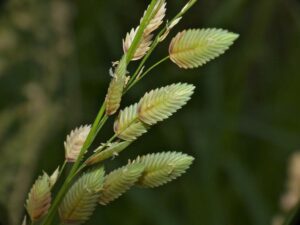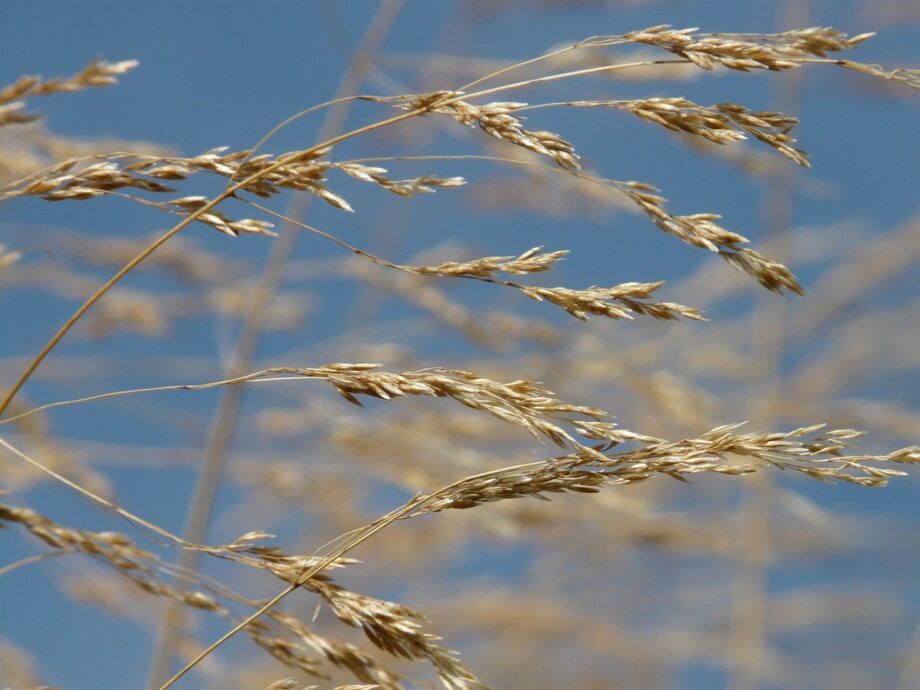Maasai love grass (Eragrostis Superba) is a perennial grass species that is native to the savannas of East Africa. This grass is particularly important to the Maasai people, who use it for various purposes, including as a symbol of love and as fodder for their livestock.
Appearance And Characteristics
Maasai love grass grows to a height of 1-1.5 meters, with a dense tufted growth form. Its leaves are long, slender, and bright green in color, with a reddish tinge at the base.
The grass produces inflorescences (flowering structures) that are made up of numerous small spikelets, each containing a single seed.
Cultural Significance
Maasai love grass is an important cultural symbol for the Maasai people, who believe the grass represents love and fidelity.
According to legend, a Maasai warrior who wishes to demonstrate his love and devotion to his bride-to-be will pluck a strand of Maasai love grass and present it to her as a gift. If she accepts the gift, it is a sign that she also loves him and is willing to marry him.
Beyond its symbolic significance, the Eragrostis Superba is also an important source of fodder for the Maasai people’s livestock. The grass is highly nutritious and palatable, making it a preferred feed for cattle, sheep, and goats.
Maasai herders often graze their livestock on Maasai love grass pastures, which can be found throughout the East African savanna.
Ecological Significance
Maasai love grass is a valuable plant species from an ecological perspective as well. Its deep root system helps to stabilize soil and prevent erosion, making it an important component of the savanna ecosystem.
The grass is also adapted to drought conditions and can survive long periods of dry weather, making it an important source of forage during times of drought.
Conservation Status
Despite its ecological and cultural significance, Eragrostis Superba is threatened by habitat loss and degradation. Overgrazing, land use changes, and climate change are all putting pressure on the grassland habitats where this species grows.
As a result, Maasai love grass is listed as “vulnerable” on the IUCN Red List of Threatened Species.
Efforts are underway to conserve Eragrostis Superba and the savanna ecosystems where it grows. Conservation organizations are working with local communities to promote sustainable land use practices that protect and restore grassland habitats.
These efforts include;
- Initiatives to reduce overgrazing,
- Promote sustainable livestock management,
- Support the restoration of degraded grassland ecosystems.
Maasai love grass is a culturally and ecologically significant grass species that is an important part of the East African savanna ecosystem. Efforts to conserve this species and its habitat are important for the Maasai people and livestock growth.
Maasai Love Grass Seeds
The grass produces inflorescences that contain numerous small spikelets, each containing a single seed. These seeds can be collected and used for the propagation of the grass.

To collect Maasai love grass seeds, it is best to wait until the grass has produced mature inflorescences, which typically happens towards the end of the rainy season.
The spikelets will turn from green to a light brown color, indicating that the seeds are mature and ready for collection.
To collect the seeds, you can cut the inflorescences off the plant and shake them gently over a container to release the seeds. The seeds can then be stored in a cool, dry place until they are ready for planting.
Planting Maasai Love Grass Seeds
Maasai love grass seeds can be planted in a variety of soil types, as long as the soil is well-drained. The seeds can be planted directly in the ground, or they can be started in pots and transplanted once they have germinated.
To plant the seeds directly in the ground, prepare the soil by removing any weeds or debris and loosening the soil to a depth of about 5-10 cm. Scatter the seeds over the soil surface, and then lightly rake the soil to cover the seeds. Water the area well, and keep the soil moist until the seeds germinate.
If you prefer to start the seeds in pots, fill a pot with a good quality potting mix, and plant the seeds at a depth of about 1-2 cm. Water the soil well, then cover the pot with plastic wrap to create a mini-greenhouse. Place the pot in a warm, sunny spot, and keep the soil moist until the seeds germinate.
Maasai love grass is a slow-growing species, and it may take several months for the seeds to germinate and the plants to establish. However, with patience and care, you can grow your own grass and contribute to the conservation of this culturally and ecologically important species.
What Is Maasai Love Grass Good For?
Maasai love grass (Eragrostis Superba) is a valuable plant species with many uses and benefits. Here are some of the ways in which love grass is good:
- Livestock Feed: Maasai love grass is highly nutritious and palatable, making it a preferred feed for cattle, sheep, and goats. The grass is also drought-resistant, making it an important source of forage during times of drought.
- Soil Stabilization: The deep root system of Maasai love grass helps to stabilize soil and prevent erosion, making it an important component of the savanna ecosystem.
- Cultural Significance: Maasai love grass is an important cultural symbol for the Maasai people, who believe that grass represents love and fidelity.
- Landscaping: Maasai love grass is also used in landscaping and ornamental gardening, as its long, slender leaves and attractive inflorescences can add texture and interest to gardens and landscapes.
- Medicinal Uses: Maasai love grass has been used in traditional medicine for a variety of ailments, including coughs, colds, and sore throats. The grass is believed to have anti-inflammatory and antibacterial properties.
- Conservation: Maasai love grass is a threatened species due to habitat loss and degradation, and efforts to conserve the grass and its ecosystem are important for both the Maasai people and the wider ecosystem in which it occurs.
Maasai Love Grass Seedlings
Maasai love grass can be propagated through seedlings, which are typically grown in a nursery and transplanted to the field when they are about 6-8 weeks old. The seedlings are usually raised in a well-prepared seedbed with fertile soil, adequate moisture, and protection from pests and diseases.
To grow the seedlings, it is advisable to follow the following steps:
- Prepare the seedbed by removing weeds, loosening the soil, and adding organic matter such as manure or compost.
- Sow the seeds in rows or broadcast them evenly on the seedbed.
- Cover the seeds with a thin layer of soil and water them gently to avoid disturbing the seeds.
- Protect the seedlings from pests and diseases by applying appropriate pesticides or using physical barriers such as nets.
- Transplant the seedlings to the field when they are about 6-8 weeks old and have developed a strong root system.
- Care for the seedlings in the field by providing adequate water, fertilizers, and pest control measures as needed.
Overall, growing Maasai love grass seedlings can be a profitable venture in Kenya, especially for farmers in arid and semi-arid regions looking to improve their livestock production through better forage quality.
Where To Buy In Kenya
Some of the places where you can buy Maasai love grass seeds in Kenya include:
- Kenya Seed Company – They have various branches across the country and sell certified grass seeds.
- East African Seed Company – They have branches in various regions in Kenya and sell Maasai love grass seeds among other seed varieties.
- Farm Input Promotions Africa (FIPS Africa) – They have branches in various regions in Kenya and sell certified Maasai love grass seeds.
- Greenlife Crop Protection Africa – They have a branch in Nairobi and sell seeds and other agricultural inputs.
- Agro-Inputs Suppliers Limited – They have branches in various regions in Kenya and sell Eragrostis Superba seeds among other seed varieties.
It is important to ensure that you buy certified seeds from reputable seed companies to ensure high quality and good yields. Additionally, it is advisable to seek expert advice on appropriate agronomic practices for growing Maasai love grass to ensure successful establishment and growth.




